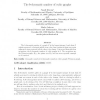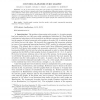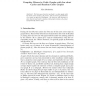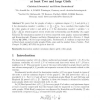125
click to vote
ALGORITHMICA
2011
14 years 7 months ago
2011
We show that computing the crossing number and the odd crossing number of a graph with a given rotation system is NP-complete. As a consequence we can show that many of the well-k...
109
Voted
GC
2010
Springer
14 years 11 months ago
2010
Springer
The b-chromatic number of a graph G is the largest integer k such that G admits a proper k-coloring in which every color class contains at least one vertex adjacent to some vertex...
108
click to vote
SIAMDM
2002
15 years 5 days ago
2002
Let Hn be the number of claw-free cubic graphs on 2n labeled nodes. Combinatorial reductions are used to derive a second order, linear homogeneous differential equation with polyno...
123
click to vote
COMBINATORICS
1998
15 years 7 days ago
1998
The aim of this paper is to give a coherent account of the problem of constructing cubic graphs with large girth. There is a well-defined integer µ0(g), the smallest number of v...
105
Voted
DM
2002
15 years 10 days ago
2002
In 1993, Brualdi and Massey conjectured that every graph can be incidence colored with + 2 colors, where is the maximum degree of a graph. Although this conjecture was solved in ...
97
Voted
DAM
2000
15 years 11 days ago
2000
We prove that there is no cubic graph with diameter 4 on 40 vertices. This implies that the maximal number of vertices of a (3,4)-graph is 38. ? 2000 Elsevier Science B.V. All rig...
102
Voted
ARSCOM
2004
15 years 12 days ago
2004
We first prove that for any fixed k a cubic graph with few short cycles contains a Kk-minor. This is a direct generalisation of a result on girth by Thomassen. We then use this the...
97
Voted
DM
2006
15 years 17 days ago
2006
In this paper we continue our investigations from [HM01] regarding spanning subgraphs which imply the existence of cycle double covers. We prove that if a cubic graph G has a spann...
120
click to vote
GC
2008
Springer
15 years 18 days ago
2008
Springer
We prove that for graphs of order n, minimum degree 2 and girth g 5 the domination number satisfies 1 3 + 2 3g n. As a corollary this implies that for cubic graphs of order n ...




